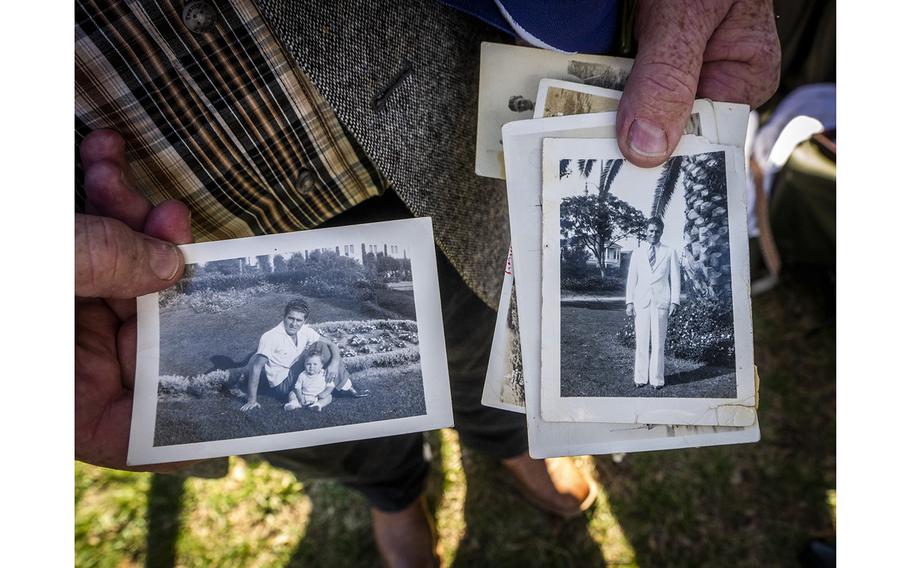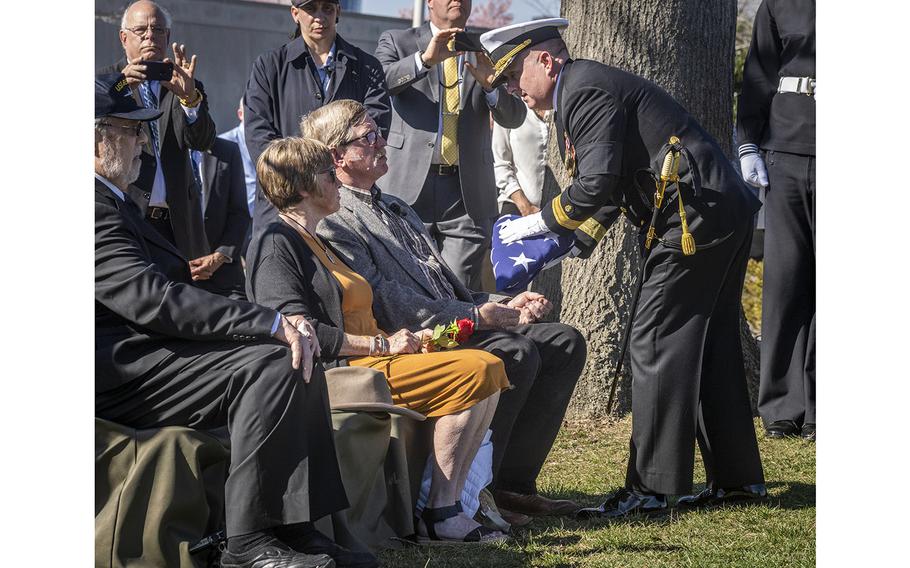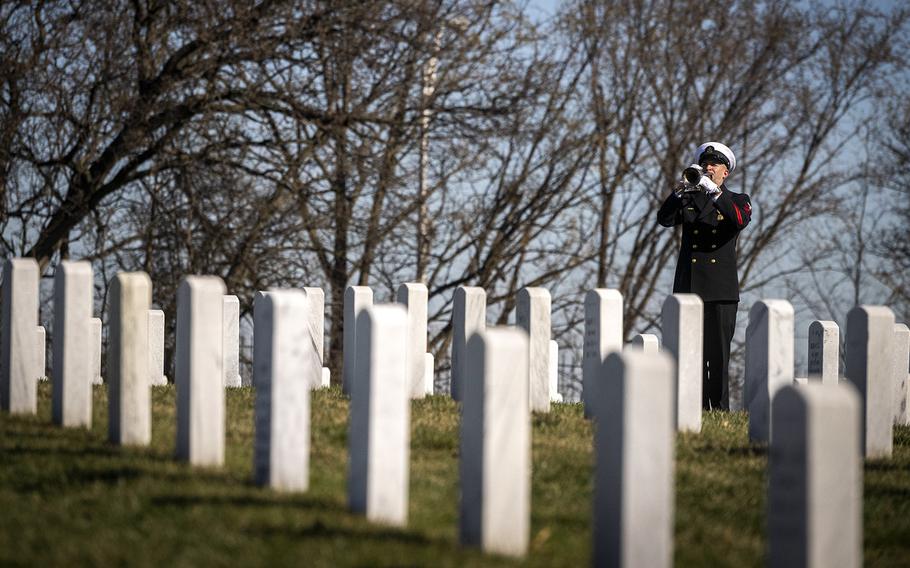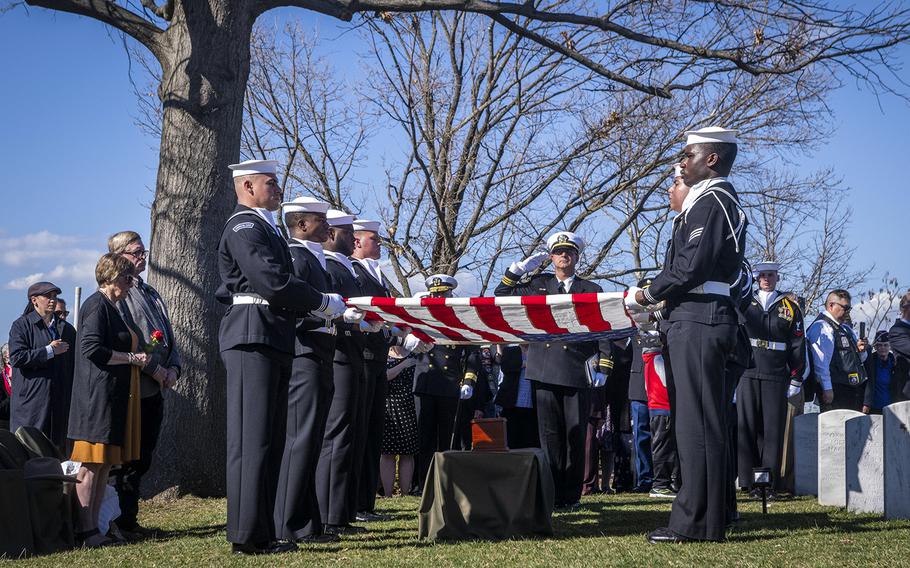
Gary Bishop displays family snapshots of Herman Schmidt, Bishop’s granduncle who was killed during the Dec. 7, 1941, attack on Pearl Harbor while serving aboard the USS Oklahoma. (Bill O’Leary/Washington Post)
None of the more than 300 people who attended Herman Schmidt's interment service Thursday afternoon at Arlington National Cemetery had ever met him. Most of those there had never heard his name until just a few days earlier.
Still, they came.
Still, they bowed their heads and prayed.
Still, they stood several rows deep under a leafless tree on a summery winter day to express their deep gratitude to the man they'd never met and whose name they'd just learned.
Schmidt, a 28-year-old from Sheridan, Wyo., with a wife and young son living in California, was one of the first American casualties of World War II, killed like scores of his fellow service members when the Japanese attacked Pearl Harbor on Dec. 7, 1941. At the time he was serving as a Navy gunner's mate third class aboard the battleship USS Oklahoma, a vessel doomed by plane-fired torpedoes that capsized it in minutes.
On the Oklahoma alone, 429 crewmen would perish, most submerged in the ship and unable to escape. Its death total was exceeded at Pearl Harbor only by the USS Arizona, which lost more than 1,100 men.
The Navy would spend three years recovering remains of those killed on the Oklahoma and later inter them in two cemeteries in Hawaii. An attempt was undertaken in 1947 to identify the remains of the sailors, but positive identifications were made in just 35 cases. The remains of the rest of the men were then buried at the National Memorial Cemetery of the Pacific, also known as the Punchbowl, in Hawaii. Schmidt was among those whose remains were not identified.
That might have been the end of the story, but in 2015 the Defense POW/MIA Accounting Agency (DPAA) began a remarkable project to try to identify the Oklahoma's victims using DNA testing as well as dental and anthropological analysis. It exhumed the bodies and, within six years, would positively identify the vast majority of the crewmen.
Schmidt's remains were positively identified in 2021 following the submission of a DNA sample by his son, Michael Schmidt, who was just 13 months old when his father was killed.

A flag is presented to Gary Bishop and his wife, Carla, during an interment service Thursday at Arlington National Cemetery for Herman Schmidt, Bishop’s granduncle. (Bill O’Leary/Washington Post)
"I'm glad it's being done," said Michael Schmidt, reached by phone at his Southern California home the night before the funeral. "I've lived with this all my life, so I'm glad it's being taken care of."
Schmidt, 82, said he and his wife have difficulty traveling and were not able to make the trip to Arlington for the ceremony.
Growing up, he said, his mother never talked about his father and so he knew very little about him. "She was part of that generation that didn't talk," he said. As he grew up, got a job and started a family, Schmidt said he didn't spend a lot of time thinking about his father.
"I don't think about what ifs. I'm not that kind of person," Schmidt said with a soft chuckle. "You know, you live your life. You work hard. And you hope you come out through the tunnel of life."
It wasn't until after he had retired from his career as a data processing consultant that he began to pore over World War II history including the attack on Pearl Harbor and the grim campaigns in the Pacific and Europe in a war that would last until 1945 and claim the lives of tens of millions around the world.
His father's sudden death at the beginning of the war had just one silver lining, according to Schmidt, who says he tries to be a positive person. It kept his father from having to suffer through the battles that would define the next four years.
"I watch a lot about World War II and the Pacific and Normandy and all these movies, everything," he said. "And who in the hell wants to go to war? ... I mean I'm glad he didn't have to go to Iwo Jima or Saipan or Midway or any of that stuff because that was brutal."
A few days before the interment, the chaplain conducting the service, Navy Lt. Cmdr. Robert Price, began to worry. He knew that Schmidt's son wasn't going to be able to attend. What if just a few people came? What if no one came?
He asked a couple of friends and emailed a few groups to let them know about Schmidt. Could they be there?
"It went gangbusters," Price said with a smile after the service, looking at the long, long line of cars that snaked past the burial site. The word spread to service academy alumni groups, Pentagon offices, military bases, the Daughters of the American Revolution and then on social media, where more people who had never heard of Schmidt decided they needed to make their way to Arlington.
Sid Wade, a retired Air Force lieutenant colonel, said he wanted to be at the service "because there should be people there to honor him."
"He never got the burial honors that others would have gotten," said Wade, who now works as a living-history volunteer with the National Park Service and greets service members who come to the World War II memorial on the Mall. "I think it's important that he does get those honors even though he died 80 years ago."
Jeremy Holmes, a U.S. Air Force colonel based at the Pentagon, said he learned about the burial in a text from a co-worker.
"He died for our freedom. That's why I'm here," said Holmes, who piloted B-52s over Iraq and Afghanistan. "I wanted to make sure he was supported." Holmes said he also came as a way to pay tribute to his recently deceased grandfather, Duttee Holmes, who was in the Navy during World War II and fought in Okinawa.
"He would have wanted me to be here, too," he said.
"We learned that the sailor was being laid to rest, and we were deeply moved by his story," said Navy Petty Officer Marolito Diaz, who is on a medical team at Joint Base Andrews and came to the service with six other sailors, all dressed in their crisp blue uniforms and white service caps. Diaz, 42, said the team checked in with their command to get approval to attend, and "they said, 'Get there.'"
While many who attended the ceremony had connections to the military, others, like Rachel Henzlik, came because they heard about the burial through social media. It was there she learned that Schmidt's son wasn't able to travel to attend the ceremony.
"I thought that was so sad and this was just one small thing I could do to express my gratitude," said Henzlik, 31.

Taps were sounded Thursday at Herman Schmidt’s interment. (Bill O’Leary/Washington Post)
At the gravesite in section 70, Price spoke to the assembled attendees about Arlington Cemetery. "It is a resting place to receive those who have served faithfully, with honor, courage and commitment," he said. "And today, GM3 Herman Schmidt takes his rightful place here on these hallowed grounds."
A remarkable silence enveloped the outdoors, the rustling of the wind and the quiet thrum of traffic the only sounds heard. Then on a hill above the gravesite seven sailors raised their rifles and fired. Then again. And again. That was followed by the playing of taps by a solitary sailor standing 50 yards away in the cemetery.
The American flag held by a group of sailors was then folded meticulously into a triangle and presented to Herman Schmidt's grandnephew Gary Bishop, 62, and his wife, Carla, who traveled from their home in Buffalo, Wyo., to represent the family.
"Overwhelming," Bishop said after the ceremony. "Just incredible to get this support. I don't know that we could have gotten this anywhere else."

Sailors prepare to meticulously fold into a triangle an American flag that was presented to Gary Bishop and his wife, who traveled from Wyoming to represent the family at the service. (Bill O’Leary/Washington Post)
Reached at his home in California on Thursday, Michael Schmidt learned about the size of the crowd of several hundred people that had turned out to wish his father the Navy's blessing of fair winds and following seas.
"Oh, wow, you're kidding me," Schmidt said. "That's great. That's really great."
The Washington Post's Michael Ruane contributed to this report.